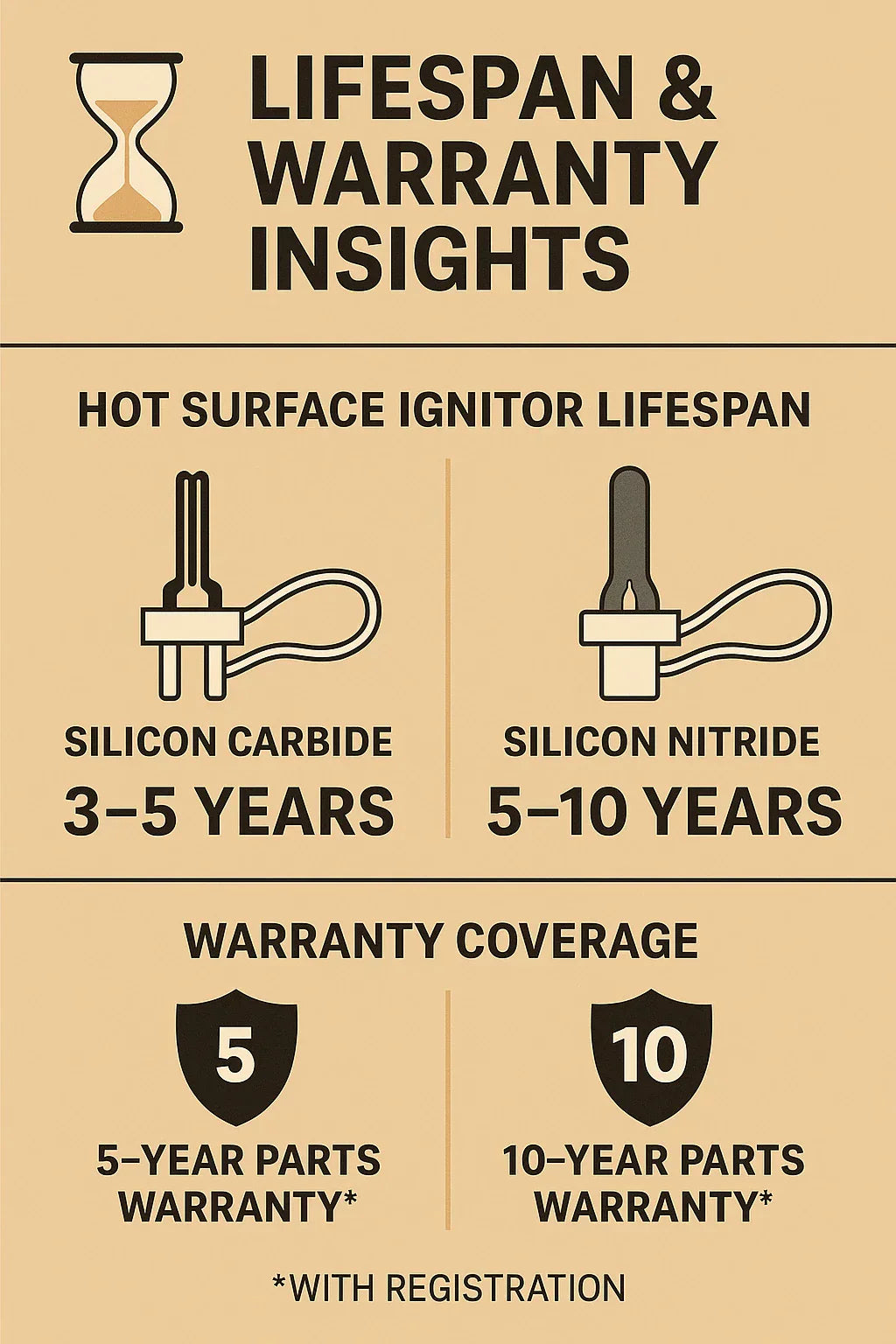When it comes to your furnace, the hot surface ignitor (HSI) is one of the smallest yet most important parts. Without it, your burners won’t light, your furnace won’t heat, and your home gets cold fast. Since ignitors are considered a wear-and-tear item, they eventually fail.
The big question for Savvy homeowners is: how long should a hot surface ignitor last, and how does warranty coverage protect you?
In this guide, we’ll cover average lifespans, what factors shorten or extend ignitor life, warranty insights from Goodman and other manufacturers, and how to plan ahead so you’re never left in the cold.
🔥 Why Lifespan Matters for Homeowners
Knowing your ignitor’s expected lifespan is about more than convenience:
-
Prevents emergency breakdowns: Anticipate replacement before peak winter.
-
Helps with budgeting: Ignitors are inexpensive parts, but service calls aren’t.
-
Protects the system: A failing ignitor can stress other furnace components.
-
Warranty planning: Understanding coverage helps you decide between DIY vs. pro service.
👉 Treating your ignitor like a maintenance cycle part (like filters or belts) is the Savvy approach.
⏳ Average Lifespan by Ignitor Type
Not all ignitors are created equal. There are two main types:
1. Silicon Carbide Ignitors
-
Used in older furnaces.
-
Average lifespan: 3–5 years.
-
Fragile: easily damaged by handling, dust, or overheating.
-
More prone to cracking under thermal stress.
2. Silicon Nitride Ignitors (e.g., Goodman 0130F00008S)
-
Standard in modern Goodman, Amana, and Daikin furnaces.
-
Average lifespan: 5–10 years.
-
Stronger, more durable ceramic composition.
-
More resistant to thermal shock and handling damage.
👉 Upgrading from silicon carbide to silicon nitride often doubles ignitor lifespan.
For deeper background, see HVAC School – Hot Surface Ignitors.
⚡ Factors That Affect Ignitor Lifespan
Even within the same furnace, lifespan varies based on usage and conditions:
-
Heating cycles per year: Heavy winter use shortens lifespan.
-
Dust levels: Dusty homes = ignitor surface contamination.
-
Voltage fluctuations: Power surges and unstable circuits can burn ignitors.
-
Filter maintenance: Clogged filters cause overheating, stressing the ignitor.
-
Handling: Touching the ignitor surface with bare fingers leaves oils that cause cracks.
👉 A well-maintained furnace can stretch ignitor life to the full 10 years. Neglect can cut it in half.
🚩 Signs Your Ignitor Is Nearing the End
You don’t need to wait until total failure — ignitors often give warning signs:
-
❌ Furnace won’t ignite (ignitor doesn’t glow at all).
-
❌ Short cycling (furnace starts and stops quickly).
-
❌ Blower runs but blows cold air.
-
❌ Clicking sounds but no flame.
-
❌ Visual inspection shows cracks, chalky spots, or discoloration.
👉 Replace at the first signs — waiting until total failure means you’ll likely discover the issue on the coldest night of the year.
For troubleshooting, see RepairClinic – Furnace Ignitor Replacement.
🏷️ How Goodman OEM Ignitors Compare
Goodman’s OEM ignitors, like the 0130F00008S, are silicon nitride designs that:
-
Last longer than universal or silicon carbide ignitors.
-
Are built to exact voltage and resistance specs.
-
Are tested for compatibility with Goodman control boards and gas valves.
-
Protect your furnace warranty.
👉 OEM = 5–10 years of reliable operation, versus 2–5 years for universal ignitors.
📜 Warranty Coverage for Hot Surface Ignitors
Goodman Warranty Basics
-
Standard parts warranty: 5 years (must register furnace within 60 days).
-
Extended parts warranty: 10 years on registered models.
-
Ignitors are covered, but labor is not.
What This Means for You
-
If your ignitor fails in year 3 → Goodman supplies the part under warranty, but you’ll still pay $100–$200 for service call and labor.
-
If you DIY the replacement → you’ll need to purchase the ignitor, since most warranties require professional installation to claim parts.
👉 Best approach: register your furnace and keep a spare OEM ignitor on hand.
For warranty details, see Goodman Manufacturing – Warranty Lookup.
🔧 DIY vs. Professional Replacement
DIY Replacement
-
Cost: $30–$80 for OEM ignitor.
-
Time: 30–60 minutes.
-
Risk: Mishandling can damage new ignitor or void warranty.
Professional Replacement
-
Cost: $150–$300 (part + labor + service call).
-
Peace of mind: Ensures warranty compliance.
-
Best option if furnace is under warranty or you’re not comfortable with electrical work.
👉 DIY is fine for older, out-of-warranty furnaces. For new systems, stick with pro replacement.
For service cost data, see Furnace Repair Costs.
🛠️ How to Extend Ignitor Life
Savvy homeowners can double ignitor lifespan with these steps:
-
Change filters regularly (every 1–3 months).
-
Keep furnace cabinet clean to prevent dust buildup.
-
Handle carefully — never touch the ignitor tip.
-
Use surge protection to prevent electrical damage.
-
Schedule annual tune-ups — techs can test resistance before failure.
👉 Prevention costs little, but saves hundreds in emergency repairs.
For preventive tips, see Energy Star – HVAC Maintenance.
✅ Final Savvy Homeowner Takeaway
So, how long should a hot surface ignitor last?
-
Silicon carbide ignitors → 3–5 years
-
Silicon nitride ignitors (Goodman OEM 0130F00008S) → 5–10 years
Warranty Coverage:
-
5-year parts coverage standard
-
Up to 10 years with registration
-
Labor not included
Best Practice:
-
Keep a spare OEM ignitor on hand
-
Register your furnace for full warranty coverage
-
Replace proactively at signs of failure
-
Maintain filters and airflow to extend lifespan
👉 With proper care, you can avoid mid-winter breakdowns and get a full decade out of your Goodman ignitor.
In the next topic we will know more about: Eco-Friendly Heating: How Reliable Ignitors Reduce Energy Waste







